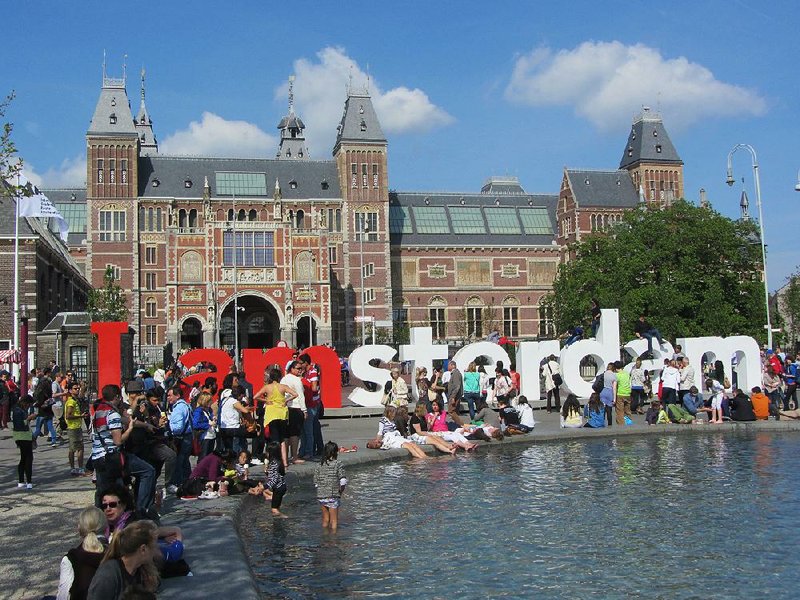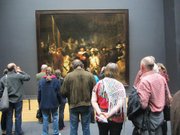AMSTERDAM - If you’ve come to Amsterdam for the cannabis, cafes legally selling marijuana in this famously tolerant Dutch metropolis remain open to foreign tourists, though that is no longer the case in some other parts of The Netherlands.
If you’ve come to Amsterdam for the culture, as cannabis-clueless wife Marcia and I did at the end of May, the reopening of the Rijksmuseum after a decade-long renovation that cost a half-billion dollars can induce another kind of high. That’s also true of the eye-popping special exhibition at the neighboring Van Gogh Museum, open again after a seven-month closing for an overhaul.
A tourist lives by more than art alone, so we did target more than those two renowned museums on our first trip to Amsterdam since 1990.
At several sites, including the always thronged Anne Frank House, we explored the entwined histories of the city’s Jewish community and the Nazi occupation of Holland during World War II. We found tranquility at the Begijnhof, one of few such convents left in Holland, with its tall old houses and front gardens arranged around a sprawling lawn.
Buoyed by mostly sunny weather, we rode canal boats and trams for sightseeing and people-watching as well as transportation. We dined merrily (and sometimes too heartily) on Dutch and Asian fare. Occasionally we puzzled over the presence of humdrum U.S. fast-food outlets the likes of Burger King, Pizza Hut and Subway. Perhaps we should have taken pride instead at this American conquest of Dutch taste buds.
We’d selected the A-Train Hotel for our six-night Amsterdam stay because it is just a few blocks from the Centraal Station transportation hub. It also seemed a fair value for about $170 a night at a time when the U.S. dollar, although strengthening a bit recently, remains weak against the euro despite all Europe’s economic woes.
The A-Train turned out to be a delight, in part because of the congenial and helpful staff. Its lobby amounted to a mini-museum of railroading filled with artifacts and photographs of the passenger service that still thrives in Europe and parts of Asia. In a wry touch, the floor leading to the elevator was inlaid with strips of black wood imitating railway ties.
A variety of money-saving transportation and museum passes can be bought in Amsterdam. We bought the ones that suited us and headed by tram to the Rijksmuseum, nowhere as large as the interminable Louvre in Paris but still packed with enough art to exhaust eyes as well as feet.
Our visit confirmed Wall Street Journal critic Jonathan Lopez’s opinion that the Rijksmuseum’s thorough revamping has created “a profoundly transformed institution, whose elegant public spaces and intelligent presentation of collections are likely to serve as models for other museums around the world in years to come.”
The only work in its same location as before, dominating the third-floor Court of Honor, is Rembrandt’s masterpiece The Officers and Shooting Company of Capt. Frans Banning Cocq and Lt. Willem van Ruytenburch, which - praise the heavens! - goes by the shorthand title The Night Watch. The huge canvas remains as marvelously expressive and detailed as we remembered from 23 years ago.
During a visit punctuated by a robust cafe lunch of cold meats and cheeses in the museum’s airy new atrium, we feasted visually on more Rembrandts, as well as other Old Masters. Included were a dozen paintings by a personal favorite, Jan Steen, whose droll 17th-century portraits of domestic life abound with vignettes of human frolics and foibles.
In several galleries tucked away on the fourth floor, the Rijksmuseum also delves into the 20th century with a potpourri of objects including a Dutch World War I biplane, art nouveau furniture and Yves Saint Laurent fashions. The most bizarre item is a Nazi German chess set. All its pieces from pawns to queens are depicted as the menacing soldiers, warplanes and other military hardware that conquered most of Europe including Holland from 1939 to 1941.
MAGNET FOR PHOTOGRAPHS
The short stroll southwest from the Rijksmuseum to the Van Gogh Museum is graced by the grassy expanse of the Museumplein, which has become a visitor magnet. Its large sculpted letters spelling out “I amsterdam” are a favorite prop for photographs, while a pond with fountains welcomes summer waders and is frozen for ice skating in winter.
“Van Gogh at Work,” the namesake museum’s show running until Dec. 1, excited and educated us about this Dutch-born genius of resplendent palette and anguished psyche.
Some 150 van Gogh paintings and drawings, along with 50 others by contemporaries who influenced him, illustrate the case made by the exhibition’s brochure that he was far from an “autodidact whose technique involved the spontaneous placement of paint on canvas using wild gestures.” Rather, he “was an artist who believed in craftsmanship, in hard work and sought support in the mastery of his art.”
Just southwest of the Van Gogh Museum stands a third major art repository, the Stedelijk, which reopened in September after work to update its facilities. We blush to admit having skipped its 20th-century treasures, though we did track down another Rembrandt painting by heading to the Amsterdam Museum.
Loaded with diverting digital bells and whistles, this city museum spans the centuries - from an amazingly intact 13th-century shoe found during an archaeological dig to a 2001 photograph of the first legal gay marriage here. The museum’s Rembrandt, The Anatomy Lesson of Dr. Jan Deijman, is the lesser known of the artist’s two works on that subject, but well worth a look.
After a tram ride southeast of the Centraal Station to the former Jewish Quarter, we absorbed some of that community’s tangled history at exhibits in four beautifully restored synagogues. It was heartening to learn that 15,000 Jews are part of Amsterdam’s human rainbow today. It was horrifying to be reminded that more than 80 percent of the 80,000 Jews living here in 1940 died in the Holocaust.
Nearby, I visited the Hollandsche Schouwburg, a former theater used by the Nazis as a deportation transit point for some of the city’s Jewish residents later shipped to Auschwitz-Birkenau and other death camps. A display alphabetically listing the surnames of those murdered includes Frank, tucked between Frangulea and Franke.
The Franks’ indelibly famed daughter continues to be mourned and venerated at the Anne Frank House along the Prinsengracht canal. This was my fourth visit to a site that continues to refine its exhibits on the Nazi extermination of Dutch Jews and bigotry in general.
The changes are worth seeing. But the heart and soul of the house, reached through the storied movable bookcase, remain the rooms where Anne and seven other Jews hid for more than two years before being betrayed and sent to their deaths, with only her father, Otto, surviving. Preserved behind glass in her bedroom is a telling touch: the pictures of movie stars that the teenager cut out of magazines. She was just 15, after all, when the Gestapo came.
ROOFTOP AND FLOATING FARE
Holland is small enough that day trips by train from Amsterdam can easily be made to any number of smaller cities - from Gouda with its cheese to Delft with its china.
It took only 20 minutes to ride the rails west to Haarlem for a sweeping lunchtime view (and a superior smoked-salmon sandwich) at La Place cafeteria atop Vroom & Dreesman department store. We’d come not for the panorama or the seafood but rather to see the splendid exhibit “Frans Hals: Eye to Eye With Rembrandt, Rubens and Titian” at the town’s museum devoted to portraitist Hals.
Odd as it may seem, two of our six dinners in Amsterdam took place at a floating Chinese restaurant, the Sea Palace. It was within walking distance of our hotel after busy sightseeing days, and its shrimp dishes were exceptional enough to merit the encore meal.
More conventionally, we savored Holland’s ties with its former Dutch East Indies colony (now Indonesia) by consuming a rijstaffel feast at Kantjil en de Tijger (The Deer and the Tiger). The 13-dish banquet, which arrived all at once like an avalanche of tapas, was delicious. A pitcher of delightfully named Gulpen beer played a supporting role.
We dined twice along the bustling Damrak and an old line eatery, De Roode Leeuw (The Red Lion). Our return was spurred by the seasonal white asparagus featured in several appetizers and main courses, along with congenial service and the Alsatian wines we favor. Another evening, we enjoyed North African fare at the bustling and brightly lighted Bazar.
Along with skipping Amsterdam’s marijuana cafes, we took a pass on a voyeuristic stroll through the city’s ballyhooed Red Light District, which incongruously surrounds Oude Kerk, the city’s oldest church.
That juxtaposition brought to mind a 1989 visit to Amsterdam with my late mother, Martha, who spent her working life as a registered nurse. On a morning walk after visiting a diamond-cutting showroom, we inadvertently took a turn that led along a narrow street where barely clad women of assorted ages and shapes posed in picture windows touting their services.
Embarrassed, I said, “I’m so sorry about this, Mom.”
She replied, “That’s OK. I’ve seen plenty of naked bodies all those years at the hospital.”
A generously tolerant soul, my mother might have been as nonchalant about the legal cannabis. Who knows? Were she still with me this time around, we could have ducked inside one of the coffeehouses along with Marcia - but just for coffee, of course.
Websites with helpful information for visitors include amsterdam.info , iamsterdam.com and holland.com.
Two useful guidebooks are AmsterdamMust Sees from Michelin and Rick Steves’ Amsterdam, Brussels and Bruges.
Travel, Pages 50 on 07/21/2013


